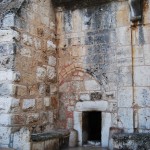The Church of the Nativity in Bethlehem (Palestine)
Bethlehem is the home city of King David and the location where Christ the Savior was born. There are several opinions about the origin of the name of Bethlehem. In Egyptian texts of the times of the XVIII dynasty of the pharaohs a settlement to the south of Jerusalem is mentioned named Bit-Laham – the house of queen Laham. In Hebrew Bethlehem sounds like “Beit-Lehem” – the city of bread. This name is not incidental: in the days of King Herod, when the Roman Empire was ruled by Caesar Augustus in a manger the Infant was born who became to all those who lived and still live the Bread of life. Bethlehem was and still is a small town located 10 kilometers away from Jerusalem. In XII century Arabs almost completely destroyed the city, the restoration of which was begun by crusaders.
Bethlehem was then destroyed two more times: in 1244 and in 1489. The vicinities of Bethlehem can tell about many Old Testament events and people of that era; the tomb of beautiful Rachel reminds us of a prophesy in Jeremiah: “A voice is heard in Rama, a cry and a bitter weeping; Rachel is weeping for her children and she doesn’t want to be comforted for they are not” (Jer. 31:15). This prophesy came true in Bethlehem when by a king Herod’s order fourteen thousand babies were killed. The main and the most precious sacred place of the city is a cave, in which Infant Jesus was born. Above the cave there’s the Temple of the Nativity – the oldest temple of Palestine. The temple on the birthplace of Jesus was built by an order of Emperor Constantine the Great.
The church was of two parts: over the grotto itself an octahedral construction of a kind of rotunda was built, and from the west a large basilica with four rows of pillars of almost today’s proportions adjoined it. Mosaic floor of Constantine’s basilica partially remained until today. Before the church there was an atrium – a wide yard surrounded from all sides by colonnade, the square of which was partially paved with tile and partially with mosaic. In 529 Samaritans revolted and almost completely destroyed the church (the above mentioned mosaic floor was covered with a thick layer of ash and broken tiling). Emperor Justinian rebuilt the church approximately on the same foundation.
A big part of the modern building has been preserved since Justinian’s time. Outside, on the facade, the church was decorated with luxurious mosaic depicting Persian magi. The story that happened here in 614 was told in the Church Council in Jerusalem in IX century: “Saint Helena ordered that the church be decorated from the western side with mosaic depicting the Mother of God with the Infant in her bosom and the worship of the magi. When the Persians invaded Bethlehem they were astonished by the picture of Persian magi-astrologists, their compatriots. Out of reverence for their ancestors they spared the church.” On the facade of Justinian’s basilica there were three entrances. Today only the central one is left, and the other two are blocked with stone.
In XII century the walls of the temple were decorated with mosaic and frescos by an order of Byzantine Emperor Manuel Komnenos (1148 – 1180). In XV century (in 1482), after the roof was damaged remodeling work was needed to be done, for which western kings Edward IV of England and Philip of Burgundy donated means. The mosaic of Manuel Komnenos almost completely peeled off. The fragments that have remained depict different events of the life of Christ: in the southern conch there’s a picture of the Lord’s entering Jerusalem; in the northern conch one can see a picture of the Resurrected Savior’s appearing before the apostles including Thomas; the third painting is a picture of Christ’s Ascension. The temple of the Nativity is located in front of a big square paved with stone.
One can enter the basilica through a narrow passage, which makes every person entering bow their heads low as if bowing down before the Infant Himself. People call these doors “the gates of humility.”
The cave where Jesus Christ was born is an underground temple of the basilica. To get into the cave one has to go through a folding door, which halfway grew into the ground, and then to descend thirty steps to the birthplace of Jesus Christ. The cave is oblong, not very deep, only about 12 meters long and 4 meters wide and about 3 meters high.
Pages: 1 2
Один комментарий
Leave a Comment
You must be logged in to post a comment.


Благодарю за Такую Информацию!